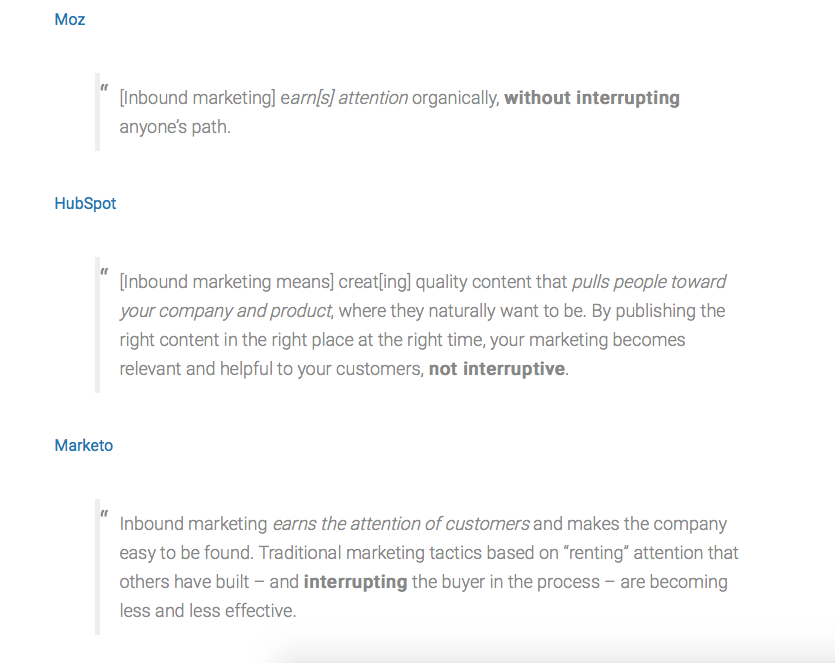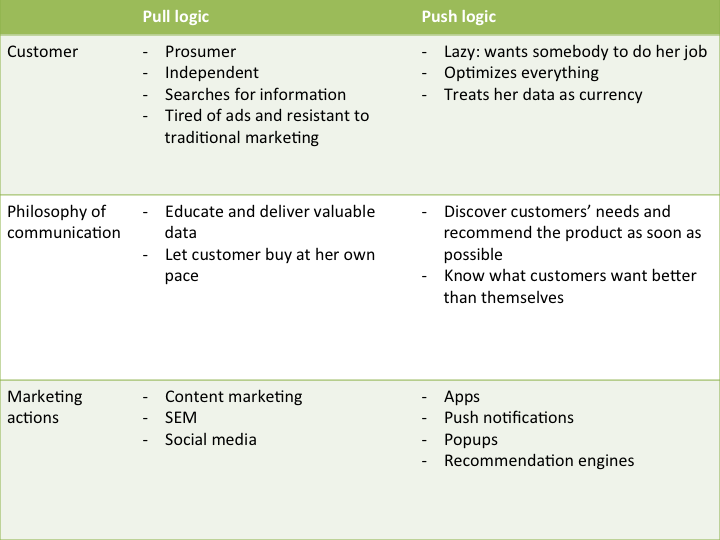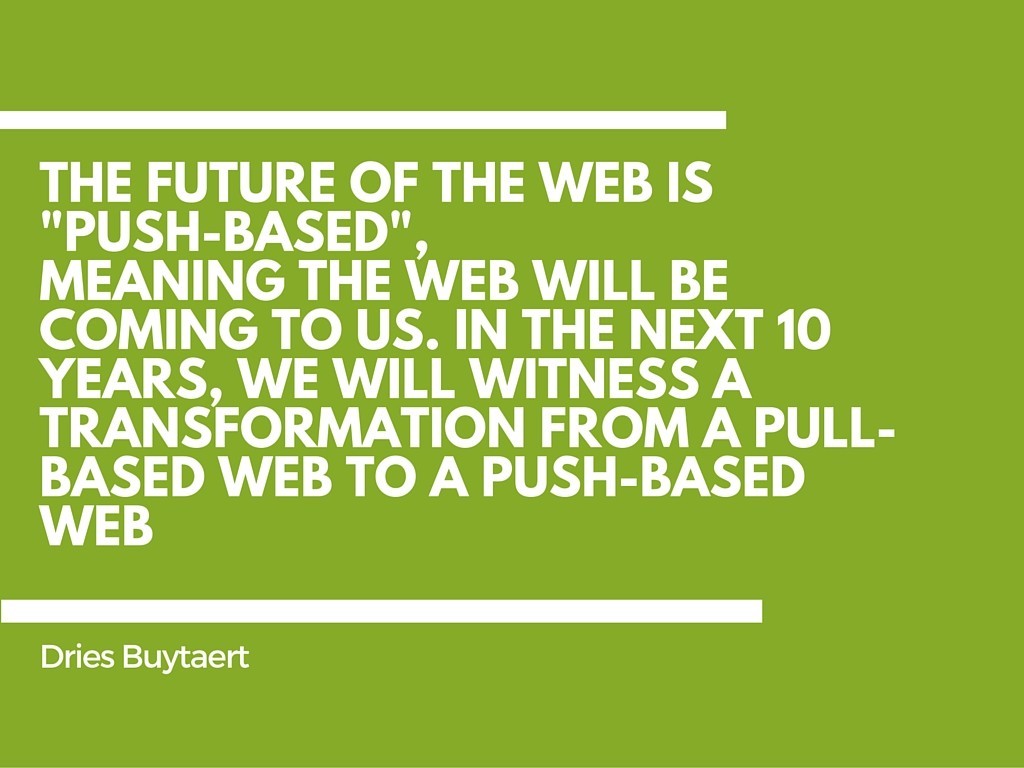 Inbound marketing is in crisis. It will become futile in the next 10 years, because the internet and the way we use it will change dramatically. After the age of pull marketing, when we attract users with valuable content, we will go back to the push era, when we actively force user to buy before the realizes her shopping need.art
Inbound marketing is in crisis. It will become futile in the next 10 years, because the internet and the way we use it will change dramatically. After the age of pull marketing, when we attract users with valuable content, we will go back to the push era, when we actively force user to buy before the realizes her shopping need.art
Mobile Marketing Automation. Download Free Ebook
But let’s start from the beginning and discuss the basic terms.
Inbound vs. Outbound, Pull vs. Push
Inbound and outbound marketing are often seen as opposed strategies.
In the inbound paradigm, we assume that the customer:
– browses the internet, methodically researching products and opinions,
– is independent and self-reliant,
– uses shopping list: she knows precisely what she wants
– is resistant to marketers loitering
– is a prosumer: has an impressive knowledge about the products and makes rational decisions
Such customer requires inbound communication because that’s the only one she could respond to. She will ignore any false-sounding or intrusive message. So we try to reach her when she is searching for information about our product, we deliver valuable content and respect her pace. We want to pull her to us, not push unwanted offers into her face. It entails focusing on content and building relationships.
Inbound means “Don’t interrupt.”
The inbound philosophy is based on “Don’t interrupt” mantra, as Jason Biddle observed:

Source: USIMPRINTS/ Jason Biddle
The inbound idea stems from the ineffectiveness of traditional marketing, based on flooding recipients with aggressive messages, according to “one-size-fits-all” approach. It doesn’t matter whether someone could become our customer or not: let’s spray everyone we can reach with our emails and banners.
Inbound marketing was called to put the end to that horror. It painted an optimistic picture of marketers and consumers engaging in conversations, brands delivering relevant information and assisting instead of forcing customers to buy. In that idyll, customers find you on their own if you provide value.
Sadly, it doesn’t apply to reality. Not anymore.
Internet: an assistant, not a catalog. Big Reverse
Why is pull marketing so attractive and efficient? Because it resonates with how the internet works. Mostly we use it as if it was a huge catalog: we run a browser to find what we need or what interests us. We know what we want to find (a particular website or a product) and look for it.In such environment, inbound practices make sense, because they correspond with the way we use the web. But that is about to change.
Writes Dries Buytaert: “The future of the web is „push-based”, meaning the web will be coming to us. In the next 10 years, we will witness a transformation from a pull-based web to a push-based web”.
What does it mean?
Products and services will find us themselves before we start searching for them. For example, if your plane is late, you will get a hotel offer before you grab your smartphone, thanks to Big Data analysis. You will get a discount on the new running shoes just when ones you use right now will start to wear off, thanks to Internet of Things and wearables (all you need is a small device built in the shoe). You will get a discount for a coffee just when you pass by the coffee shop, thanks to beacons and geolocation. An app will remind you of a car service because it knows how much have you driven.
You won’t have to type: hotel, running shoes, coffee nearby or car service in your browser. Apps, media, and platforms will do that for you. The internet will transform from an enormous catalog into your virtual personal assistant.
Towards the push logic: Facebook
How does Facebook work? You open it and get all the information you need instantly: you don’t have to browse it to check what your friends are up to or whether there is something interesting going on tonight or whether your favorite blogger has posted anything new. . You get all that knowledge immediately, without a need to search for it. Facebook serves you a perfectly composed dish, basing on your profile and history of your interactions. It does all the searching, choosing the most interesting and relevant pieces for you, so you can just sit, relax and refresh. Most of us doesn’t even go to the websites with original content – the collection Facebook has aggregated for us seems perfectly fine.
That’s how push logic works. Zuckerberg’s medium doesn’t wait for you to search “What is my mom doing” – it just pushes that information to you. Because of its careful data analysis, it knows that you prefer to see A, B and C, not X, Y or Z. Consumer doesn’t have to search anymore because Facebook becomes her concierge: it lets some guests in, and to others it politely says that nobody’s home, it segregates your messages and press, and reminds you of important events.
Browsers are dead, or what is Google Now
The second company recognizing that change is Google, who produced a new generation browser-assistant dedicated for mobile devices. It integrates data from many sources: both your own (browsing history, calendar, geolocation) and external ones (weather, traffic, web resources), so it can inform you when to leave home to arrive at the planned appointment on time.
Google Now wants to expect your desires – react to your needs in real time to streamline and optimize your everyday life.
Appification of the world
The internet has been changing in that direction for a long time because of mobile apps and their impact on web design.
We underestimate the role of the mobile channel. Its omnipresence transforms not only the tools we use but also the practices of using the internet, what entails an entirely different approach to relationship with visitors.
As Raj Aggarwal points out, apps offer an interactive experience. On the contrary to the traditional websites that just collect content, apps serve accomplishing tasks. They aren’t limited to mobile apps: we have them on our desktops or in smartwatches or IoT devices. Apps make our lives easier. Also, most customers prefer to use brand’s app than to visit its website – it’s more convenient.
Today more and more sites resemble apps and work like apps. They don’t just contain information but help us perform tasks and collect data on users’ behavior to streamline processes and recommend us the best solutions.
Appification of everything means that consumers get used to such approach. They don’t want to browse, read and shop, but prefer to optimize their tasks. That’s why the push logic (when we suggest before users start to browse) is the future of the web: both mobile apps and the internet as such
Why popups came back?
That appification trend, when apps become more popular, and websites and e-stores become app-like, is reflected by growing popularity of popups. We associate popups with web design from 90., yet today Armando Roggio, Practical Ecommerce expert, calls them the hottest trend for 2016. Why? Because they operate according to push logic: they tell user what to do before a user starts to search. But today their efficiency relies on Big Data technology.
Big Data
Push practices must meet one vital condition to be effective: they must be perfectly tailored to the context:
– to user’s interest: her browsing history, products viewed or bought, content she consumed
– to her engagement: frequency of shopping and visits, the duration of the relationship, her knowledge of the product (to assess that you can use lead scoring)
– to the situation she finds herself in at the moment (place, time, sometimes weather or traffic are important factors)
– to customer’s habits (for example, when she shops or reads newsletters)
– to recognized patterns in customers behavior (for example, customers who buy product A, often buy also product B).
Users expect offers to be perfectly tailored to their needs, and when it comes to push notifications, they are much more critical. 13,4% of consumers opt out if newsletters don’t meet their needs while as much as 36,4% resign from push notifications that seem irrelevant.
That’s why all push communicates (notifications, popups, banners, SMS, etc.) must be highly personalized.
What it all means for marketers?
The pull logic, on which inbound marketing is founded on, will be on the way out. The other problem is that the opposition between inbound and outbound (or pull and push) has always been exaggerated: in their everyday practice all marketers combine the two to achieve their aims. Maybe the future will force us to redefine that opposition.
The upcoming triumph of push mechanics won’t threaten the role of valuable content or relationship building. It will make us focus on different parts of marketers’ activities.
Which practices will become the most important for the future marketing?
– Recommendation engines: will enable us to use collected data to suggest products and content and discover what customer needs before she realizes that herself
– Personalized popups and banners: we must abandon the idea that the website is something static, equal to all users. No! popups and banners should be customized for each user
– A need to integrate data from the mobile app and traditional, desktop Marketing Automation Platform: as mentioned above, many customers prefer to use brand’s app than to visit its website. But in apps they leave a lot of precious data, so it’s time to learn how to integrate that knowledge with your MAP. Maybe your contact hasn’t visited your website enough times to let you personalize the content. But if she installed your app (and if you use Mobile Marketing Automation), you know what other apps has she installed. Exchanging data between an app and traditional MAP will allow you to display a customized banner thanks to the knowledge obtained from her behavior in a mobile app. It also works the other way round: when you know what user bought or viewed on her computer, you can customize the push notification you send when she passes by your physical store.
– Mobile marketing automation: personalize your mobile marketing and unlock the full potential of your app.
– Content-automation alliance: we will need more content and education because customers remain hungry for knowledge, but they will want us to spare them the effort of searching for information they require.
– Bridging online-offline gap: the perfect example of push logic are actions aimed at bridging online- offline gap, such as beacons or mobile apps. You can combine the knowledge about user’s behavior in the physical store and e-store to recommend the most relevant products wherever she is.
Marketing without interruptions, customers wandering across the internet, searching for expert knowledge, engaging in conversations with competent brand’s representatives, and making rational shopping decisions – that’s beautiful, but not realistic. When consumers attention is governed by the economy of push, you can’t wait for researching user to find your company.
In the next decade, everything will start to operate as a highly personalized app that realizes your wishes before you know them and works as an assistant.


 Follow
Follow
















